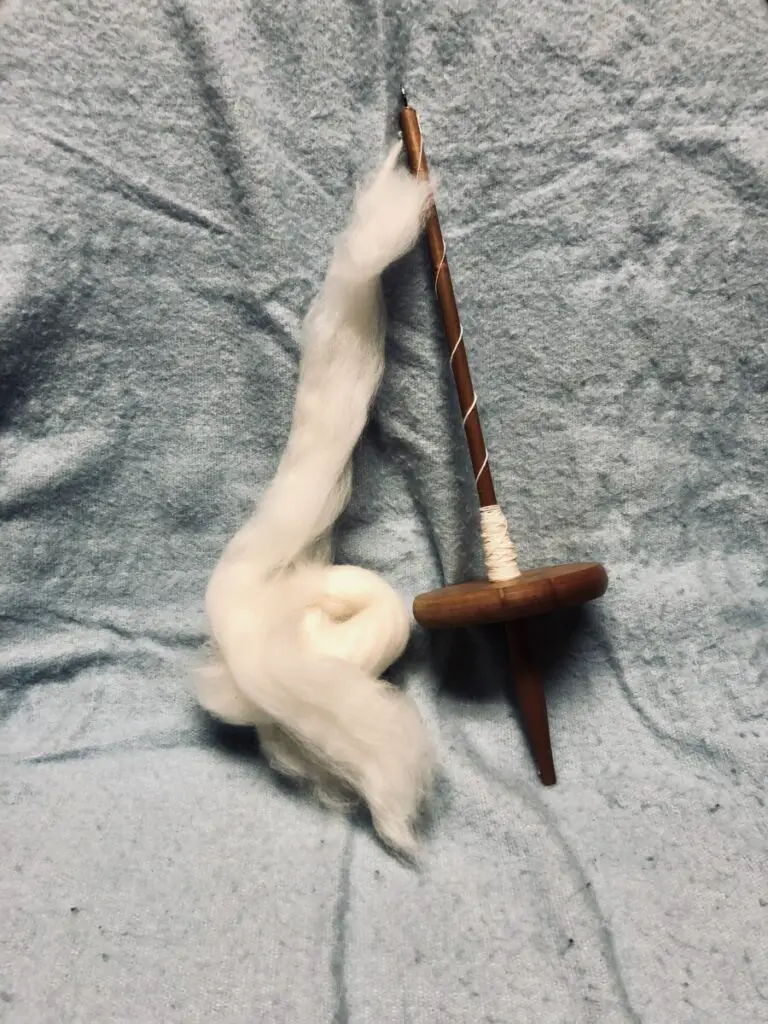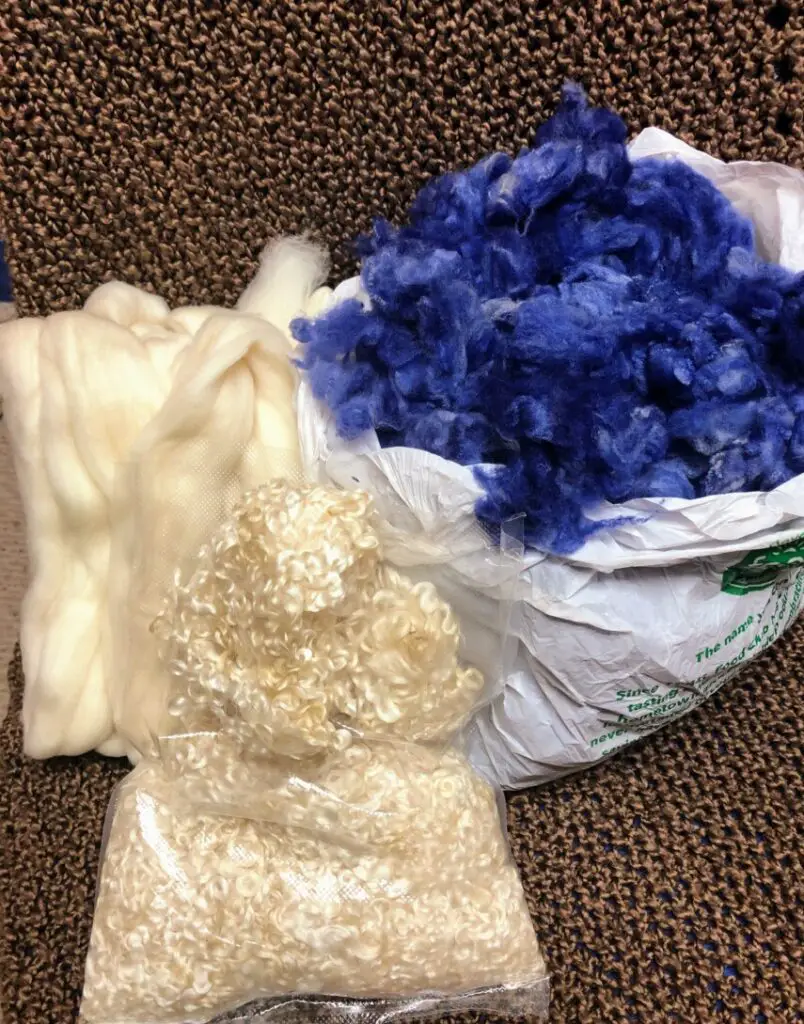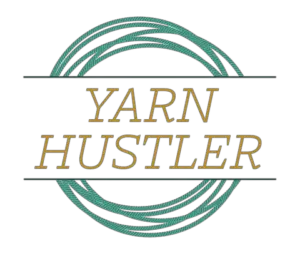Are looking to get into spinning yarn? Well, let me be the first to welcome you to the Darkside. When you’re trying something new it can be overwhelming, and you might start wondering: is spinning yarn hard? And how do you make it easier?
Spinning yarn is not hard if you have the right tools and resources. You also need to be okay with making mistakes, no one gets it right on their first try. But, with some practice, and a heavy dose of fun, you’ll make something you can be proud of.
Finding the right tools and resources can be an undertaking in and of itself, in this article we’ll go over the things you need to get started. I’ll also give you some tips on how to get you ready to start your own fiber adventure.
Before we get into any of that though, we need to discuss just what exactly spinning yarn means.
Table of Contents
What is Spinning?
Oh boy, I started with a doozy, but I’ll give it a shot.
Spinning is defined as the action or process of converting fibers into thread or yarn. That’s a great definition, but how does it work?
The action of spinning yarn is typically done by twisting fiber until it’s twisted enough to not break apart when pulled. This can be done in numerous different ways ranging from using a spindle or spinning wheel to hand twisting the fibers.
We’ll get into what a spindle and spinning wheel are in the next section, so let’s talk about that all important twist.
Twist is the thing that literally holds all yarn and thread together. Without twist, you’d just be left with a pile of fluff which is called fiber.
So, how can twisting the fluff make yarn? I’m so glad you asked.
Twist is all about friction, when all the individual fibers of your fiber are twisted together, there’s so much friction that you can’t pull them apart again. This is what makes yarn, yarn.
There are some other variables that affect the kind of yarn you make, such as fiber and drafting, but at its core, spinning is just twisting fluff until it won’t fall apart.
If you wanna know how it is that a spinning wheel can do all these awesome things, here’s how a spinning wheel works.
Now that you know that you just need to twist stuff, let’s talk about the things that make that easier.
Tools of the Trade
There are a few things that you need in order to start spinning some yarn, these items can range from fairly inexpensive to pricey. But, all you need to get started is some fiber to spin and something to spin it with.
Spindles

Spindles are the simplest, cheapest way to get started spinning yarn. But that doesn’t mean they can’t still produce quality yarn.
The picture above is a spindle, it’s my first attempt spinning with a spindle after a year of exclusively using a wheel actually. Spindles come in a variety of shapes, sizes, and materials, I’ve even seen some people make spindles out of pencils and old CDs!
A spindle works by getting the spindle spinning and then allowing the twist you’re creating to travel up the fiber to create yarn. It’s easier to see in action than to describe, so here’s a video that shows it all step by step.
Learning to spin on a spindle is a great way to get started without spending a lot of money. You still learn how to spin and the science behind it. I learned to spin on a spindle, now I prefer to use my spinning wheel but there are lots of people that spin exclusively on spindles.
If you’re interested in getting started with a spindle, you can buy them online from a variety of places such as Etsy, Ashford, The Woolery, and Paradise Fibers. You can also ask to borrow one from someone you know, look for a local fiber shop that sells them, or look to see if you have a local Spinning Guild that will help you get started.
Spinning Wheels

The spinning wheel above is my spinning wheel. Her name is Kirby and she’s an Ashford Kiwi 3.
Spinning wheels are the big brother of the spindle. They both do the same thing, add twist to fiber to create yarn, but the way they do them is different.
While you spin spindles with your hand, you get spinning wheels spinning by moving peddles, called treadles, up and down with your feet. This makes the big wheel spin, which spins the flyer, which puts the spin into the fiber and winds the yarn onto the bobbin.
Whew, that was a lot. Luckily for you though, I thought ahead and I have a post all about how spinning wheels work.
But, not all spinning wheels are created equally, some have bigger wheels, and some have one treadle instead of two but the mechanics are the same.
Now, there is also something called an espinner that is becoming more and more popular. These little guys are a great option if you don’t have enough space for a wheel, can’t use your feet to treadle, or need a more portable option. Here’s a video for more information about them.
Spinning Wheels are more of an investment than a spindle, with espinners being a cheaper option than full wheels. But, if you’ve decided to get into spinning, getting a spinning wheel is a great investment.
The biggest names in spinning wheels are Ashford, Kromski, Scacht, and Louet. I know there are a ton more out there, but these are the brands you’ll probably see the most.
If you’re interested in getting a wheel but don’t know which one to buy, here’s a video that breaks down how to choose a spinning wheel and considerations you might want to think about when buying one.
Fiber

The last thing you need to start your spinning adventure is some fiber to get started with.
Fiber is the fluff to which you add twist to make yarn. As you can see from the picture, fiber comes in all different shapes and sizes.
In the above picture, the fiber on the left is an undyed fiber that’s been commercially processed in a mill, the blue fiber on the right is fiber I washed and dyed but it’s been unprepared, and the last little curly cues are called locks and were cut right off the sheep.
Fiber can be from an animal (like sheep, llama, and yak), plants (like cotton, flax, and hemp), or made in a factory (like acrylic, nylon, and polyester).
The best place to start with spinning is with wool. Wool can be from a ton of different breeds of sheep though. So which one to choose to start?
I would recommend starting with one of the following breeds: Rambouillet, Blue Faced Leicester (sometimes abbreviated as BFL), or Romney. These breeds are grippy and so will be easier to draft and spin with.
A lot of fibers are produced in large mills. These mills will steam the fiber sometimes, to make the fibers of the wool align better. This is great at giving you a nice shiny yarn but, it also makes the yarn slippery because it takes the crimp out of the wool.
If you’re having trouble keeping a hold of your fiber, try this: take your roving or top and lay it out on a towel, then spray it with some water. You don’t have to get it completely soaked, just spray both sides and then let it dry.
If your fiber has been steamed, the water will make the crimp spring back. After your fiber has dried, try spinning it again. If this was the problem you were having it should be easier to spin.
You might be wondering, ‘Where’s the merino?’ While Merino is a very common wool and easy to get a hold of, it’s not the easiest to spin. Merino can be slippery which means that it can get yanked out of your hands while you’re trying to spin it. For this reason, I wouldn’t recommend trying to spin Merino on your first try.
Once you’ve gotten the hang of spinning wool, you can experiment with spinning different fibers or blends of fibers. The possibilities are endless!
You can buy fiber easily online at shops like The Woolery, Etsy, and Paradise Fibers just to name a few. You can get plain white or natural fibers, as well as fibers dyed in a ton of different colors. Have fun picking out your first fiber!
5 Tips for the Beginning Spinner
Starting a new hobby can be overwhelming and you might get frustrated enough to give up. But, I’ve got some tips for you that will help you get going and keep going.
1. Watch Other People
Now at first glance, you might think this tip is a little creepy. But what I mean by this is: watch other people spin. YouTube is a great resource for this. There are hundreds of videos of people spinning yarn on a wheel, with a spindle, with different materials, techniques, and preparations.
I would also recommend that you don’t stick with just one person, watch a lot of different people. Everyone does things differently and what works for one person may not work for you. It’s good to get a variety of views and opinions so you can mix and match to see what works best for you.
I’m not going to lie, I lot of what I learned about spinning I learned from watching youtube videos.
But, apart from YouTube, you can also take in-person classes, go to demonstrations, or find a group of local spinners (sometimes called a guild) and watch them spin.
Regardless of how you do it, get out there and watch people spin yarn.
2. Give Yourself a Break
Look. You’re new at this. You’re not going to do it perfectly the first time. I know I didn’t. My first yarn was a chunky, ugly, twisty tangle. So, my next tip is to give yourself a break.
Even if you try and your yarn is the ugliest thing you’ve ever seen, guess what? You made it! You created that ugly tangle out of a pile of fluff. How cool is that?!
Like I said earlier, my first yarn was ugly and barely usable, but I stuck with it, and now I’m proud to say that some of (definitely not all) the yarns I make could pass as store-bought yarns. I never would have gotten where I am if I hadn’t made that first ugly yarn.
3. Try New Things
I know, I know, You’re already trying something new by spinning yarn. But, I’m more talking about after you get started.
Once you’re getting more comfortable spinning a continuous strand, try switching it up. Spin a different way, try a new fiber, or spin a chunky art yarn.
If you want to get real crazy, you could even try dyeing your yarn in the microwave!
One thing you’ll find about spinning is that there’s always more to learn. And, trying something new, even if it’s not very successful, can help you learn and grow as a spinner.
4. Let your Creativity Go Wild
This tip goes hand in hand with trying new things. One of the great things about spinning is that there are so many ways to do things that you can be wildly creative.
You can use that creativity to recreate a specific type of yarn you saw or spin for a specific project in mind.
But, sometimes it’s good to spin just to make something new. Don’t get too caught up in spinning the perfect yarn. Embrace the imperfections. Make that crazy yarn, purposefully make a super thick yarn, throw in that color that you’re not sure goes with the other colors.
What I mean is, spin without a plan, just let it happen and let your creativity go. I have spun a few yarns that I have absolutely no idea what to do with. But, I had an absolute blast creating them.
If you ever find yourself stuck in a spinning slump, I recommend trying this to get back to the joy of spinning.
5. Keep Spinning
To modify a quote from Finding Nemo: Just keep spinning, just keep spinning.
Even if you’re frustrated, even if you don’t think you’re good enough, even if you don’t like the yarn you’re making, just keep spinning!
You’ll get better! All those people you see online that you’re comparing yourself to have had years and years to practice their craft. But, they all started right where you are, wading through the information, trying to figure out how to even get started, and wondering what all these weird words mean.
Don’t give up! Practice makes better, all you have to do is keep spinning.
Wrap Up
There was a ton of information in this post! Good on you for reading it all.
We talked about the difference between spinning wheels and spindles and what fiber would be good to try for your first project.
We also talked about my five tips to give to a new spinner. They are: watch other people, give yourself a break, try new things, let your creativity go wild, and just keep spinning.
I hope this post has shown you that spinning isn’t too hard and it’s definitely worth the challenges.
Now use your newfound knowledge and go make something awesome!

